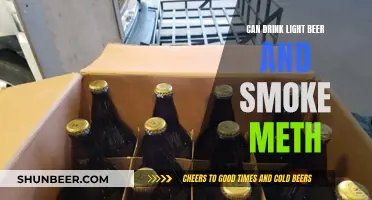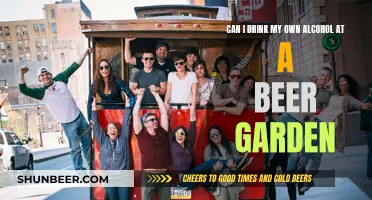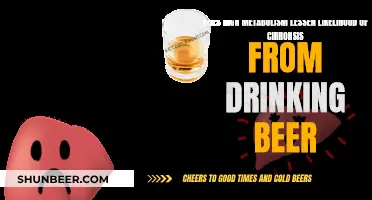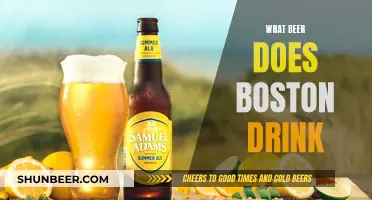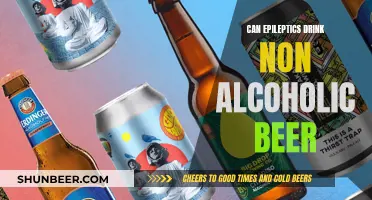
Whether or not actors are drinking real beer in movies is a question that has intrigued many a viewer. While some performances make it seem like the actor must be intoxicated, actors typically do not drink actual alcohol on set. Instead, they consume non-alcoholic beer or other prop drinks, allowing them to behave as if they are drinking without the effects of alcohol. This is particularly important when multiple takes are required, as drinking alcohol repeatedly would lead to impaired performance and safety concerns.
However, there have been exceptions where actors have consumed alcohol for authenticity or shown up drunk for various reasons. For instance, Robert Shaw in Jaws, Shia LaBeouf in Lawless, Fred Astaire in Holiday Inn, and Martin Sheen in Apocalypse Now are all examples of actors who drank alcohol on set, whether by choice or otherwise.
| Characteristics | Values |
|---|---|
| Why is real beer rarely used in movies? | To avoid the effects of alcohol, especially during scenes that require multiple takes |
| What is used instead of real beer? | Non-alcoholic beer, coloured water, weak tea or herbal teas, prop beverages designed to mimic the appearance and taste of beer |
| Why are these substitutes used? | To maintain the actors' safety and well-being, to ensure the illusion of authenticity on screen, to match the scene's requirements and the director's vision |
What You'll Learn

Non-alcoholic beer is used as a stand-in for real beer
Non-alcoholic beer is the most common stand-in for real beer in movies. This is to avoid the effects of alcohol, especially during scenes that require multiple takes. Non-alcoholic beer looks and pours like traditional beer, allowing actors to maintain their composure and performance level throughout filming.
Non-alcoholic beer is also used as it can be consumed in large quantities without affecting the actors' safety and well-being. This is particularly important for close-up shots or scenes where the authenticity of the drink plays a crucial role in the storytelling.
In some cases, coloured water can be used as a substitute for beer, especially when the appearance of beer is needed but its unique characteristics, such as foam and exact colour, are not critical. For scenes requiring darker ales or stouts, weak tea or herbal teas are used for their similarity in colour.
The film industry also relies on specialised movie prop companies that create non-alcoholic beverages designed to mimic the appearance and taste of beer. These prop beverages are often used for close-up shots or scenes where the drink's authenticity is crucial to the narrative.
One example of a popular prop beer is Heisler Beer, a fictional brand created by the Hollywood prop house Independent Studio Services. Heisler Beer has been featured in various TV shows and movies, including "Grey's Anatomy", "Brooklyn Nine-Nine", "It's Always Sunny in Philadelphia", and "Stranger Things".
Overall, the choice of substitute depends on various factors, including the scene's requirements, the director's vision, and the need to ensure the actors' safety and well-being, while maintaining the illusion of authenticity on screen.
Is Root Beer Safe for Children?
You may want to see also

Coloured water can be used when the appearance of beer is needed, but its unique characteristics are not
When it comes to filming scenes involving beer, it is essential to maintain the illusion of authenticity while ensuring the actors' safety and well-being. Coloured water serves as an effective substitute when the appearance of beer is needed but its unique characteristics, such as foam and exact colour, are not critical.
Using coloured water as a beer prop offers several advantages. Firstly, it is a simple and economical solution. Water can be easily tinted to resemble the golden hue of beer, and with the addition of a small amount of dish soap, a frothy head can be created. This approach is particularly useful for wide shots or scenes that do not require close-up views of the beverage.
Additionally, coloured water allows for multiple takes without the risk of inebriating the actors. As filming often involves numerous takes and different camera angles, using real beer could lead to actors consuming excessive amounts of alcohol. Coloured water ensures that actors can maintain their composure, performance level, and safety throughout the filming process.
In some cases, the production team may opt for other alternatives to coloured water. Non-alcoholic beer, for instance, can be used when a more authentic look is required, as it pours and behaves like traditional beer without the intoxicating effects. For darker ales or stouts, weak tea or herbal teas can be utilised due to their similar colour and safety for consumption.
Moreover, specialised movie prop companies create non-alcoholic beverages designed to mimic beer in appearance and, occasionally, taste. These bespoke drinks are ideal for close-up shots or scenes where the authenticity of the beer is crucial to the narrative.
Ultimately, the choice of beer substitute depends on various factors, including the specific requirements of the scene, the director's vision, and the need to balance realism with the well-being of the cast and crew. Coloured water, as a versatile and practical option, remains a popular choice when the appearance of beer is needed but its unique characteristics can take a back seat.
Drinking Beer While Driving a Lawnmower: Is It Legal?
You may want to see also

Tea is used for scenes requiring darker ales or stouts
When it comes to filming scenes that require the presence of drinks, the film industry has a few tricks up its sleeve to ensure the actors' safety and maintain the illusion of authenticity. Tea, in particular, plays a starring role in this regard.
For scenes demanding darker ales or stouts, tea is often the go-to substitute. Weak tea or herbal teas are carefully selected for their similarity in colour and their safety for consumption in large quantities. This ensures that the actors can deliver their lines without worrying about the potential side effects of drinking copious amounts of real ale or stout.
The choice of tea provides a visually appealing alternative, maintaining the suspension of disbelief for the audience. The colour and consistency of tea closely mimic that of the intended alcoholic beverage, ensuring that even the most discerning viewer is none the wiser.
The art of illusion in cinema is a delicate balance between realism and practicality. By employing tea as a stand-in for darker ales or stouts, filmmakers can achieve the desired aesthetic without compromising the actors' performance and well-being.
The use of tea as a prop beverage is a testament to the meticulous attention to detail that goes into crafting believable scenes. It showcases the creativity and practicality poured into every sip, ensuring that what seems like a real, frothy brew is often an expertly crafted illusion.
Understanding the Basics of Draft Beer Systems
You may want to see also

Whiskey is often replaced by iced tea
When it comes to filming scenes involving alcohol, the drinks you see on screen are rarely the real deal. This is to avoid the effects of alcohol, especially during scenes that require multiple takes. So, what do filmmakers use instead of whiskey? One common substitute is iced tea.
Iced tea is a popular choice for several reasons. Firstly, it closely mimics the colour and consistency of whiskey, providing a visually convincing stand-in for the amber-hued spirit. Additionally, it is a familiar and palatable drink, making it a convenient option for actors who may need to consume it in multiple takes. Iced tea also has the advantage of being a low-calorie beverage, which is important to avoid actors consuming excessive amounts of sugar or calories during filming.
The use of iced tea as a whiskey substitute is a well-known trick in the film industry. In the classic 1978 comedy "Animal House", John Belushi's character chugs an entire bottle of what appears to be whiskey. However, sources suggest that the bottle was actually filled with iced tea. This substitution allows for a dramatic scene without risking the actor's health or performance.
While iced tea is a popular choice, it is not the only option for whiskey stand-ins. Apple juice is another common alternative, providing a similar colour and consistency to whiskey. For scenes where the appearance of whiskey is needed but its unique characteristics are not critical, coloured water can be used. In some cases, specialised prop beverage companies create non-alcoholic drinks designed to mimic the appearance and taste of whiskey, providing an even more convincing option for close-up shots or pivotal scenes.
The choice of substitute ultimately depends on the specific requirements of the scene, the director's vision, and the need to ensure the actors' safety and well-being. While the drinks may look like whiskey on screen, they are carefully chosen to avoid the effects of alcohol and maintain the actors' performance and composure.
Beer and UTI: What You Need to Know
You may want to see also

Vodka is substituted with water
When it comes to filming scenes involving alcohol, the drinks you see on screen are rarely what they seem. Vodka, for example, is often substituted with water.
The goal is to avoid the effects of alcohol, especially during scenes that require multiple takes. Water is a simple, effective stand-in for vodka as it has a similar clear, colourless appearance. However, it lacks the ethanol that gives vodka its distinctive kick.
For scenes where the appearance of vodka is needed but its unique characteristics are not critical, coloured water can be used instead. This technique is also used for other clear spirits, like whiskey, where the bubbles and foam of real alcohol would be noticeable.
In some cases, non-alcoholic vodka is used. This allows actors to maintain their composure and performance level throughout filming, without the side effects of alcohol.
The choice of substitute depends on various factors, including the requirements of the scene, the director's vision, and the need to ensure the actors' safety and well-being. Ultimately, the illusion of authenticity on screen is what matters most.
Mixing Beer and Rum: A Safe Drinking Adventure?
You may want to see also
Frequently asked questions
No, actors do not usually drink real beer on set. They are given prop drinks, which look like beer but do not contain alcohol. This allows them to behave as though they are drinking without actually consuming alcohol.
There are several reasons why actors avoid drinking real beer during filming. Firstly, performance issues—being under the influence of alcohol can make it difficult for actors to deliver their lines, understand the director's requests, and control their performance. Secondly, multiple takes—if actors consume alcohol during each take, they will need to drink repeatedly, which could result in them becoming too intoxicated to continue filming. Lastly, safety concerns—alcohol affects motor skills, and an intoxicated actor may lose their balance, trip, and sustain injuries, creating a liability issue for the production company.
Actors typically drink non-alcoholic beer as a substitute. For scenes where the appearance of beer is not critical, coloured water or herbal tea can also be used due to their similar colour and safety for consumption.



